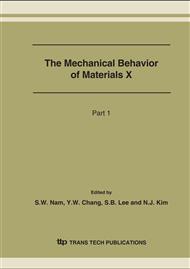[1]
H. Matsuno and Y. Mukai: Key Engineering Materials, Vol.274-276 (2004), p.181.
Google Scholar
[2]
H. Matsuno and Y. Mukai: Proc. PVP2004, Vol. 482(2004), Paper No. PVP2004-2760, p.167.
Google Scholar
[3]
H. Matsuno: Proc. PVP2005, Vol. 3(2005), Paper No. PVP2005-71529, p.307.
Google Scholar
[4]
H. Matsuno, H.: Proc. AEPA2006(2006), Paper No. J-030, to be published.
Google Scholar
[5]
U. Essmann, U. Gosele, H. Mughrabi: Phil. Mag. A. Vol.44(1981), p.405.� � σσσσw2 σσσσw1 1 0 −−−−1 REQ −−−−2 −−−−3 −−−−4 −−−−5 � Kt∆∆∆∆σσσσN σσσσ w 2 1 0 −−−−1 REQ −−−−2 −−−−3 � Kt∆∆∆∆σσσσN � σσσσw2 σσσσw1 1 0 −−−−1 REQ −−−−2 −−−−3 −−−−4 −−−−5 � Kt∆∆∆∆σσσσN Fig.5 Classification of fatigue strength diagrams (REQ - ∆σNR diagrams). (a) Group A: σw1 σw2 -transition type. (b) Group B: σw2-dominant type. (c) Group C: σw1 σw2 -mixed type.
Google Scholar


